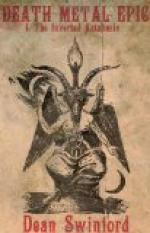It was at the court of Frederick II, in Sicily, that the first real school of Italian poetry developed, and from there the custom of composing exclusively in the vernacular spread over the remainder of the country. These early poets chose love as their main topic, and closely imitated the Provencal style. Then the “dolce stil nuovo,” or sweet new style, was introduced by Guinicelli, who is rightly considered the first true Italian poet of any note. The earliest Italian epic, the “Buovo d’Antona,” and an adaptation of Reynard the Fox, were current in the first half of the thirteenth century at Venice and elsewhere. In the second half appeared prose romances, such as tales about Arthur and his knights, the journey of Marco Polo, and new renderings of the old story of Troy.
Professional story-tellers now began to wander from place to place in Northern and Central Italy, entertaining auditors of all classes and ages with stories derived from every attainable source. But the first great epic poet in Italy was Dante (1265-1321), whose Divina Commedia, begun in 1300, is treated separately in this volume. Although Petrarch was prouder of his Latin than of his Italian verses, he too greatly perfected Italian poetry, thus enabling his personal friend Boccaccio to handle the language with lasting success in the tales which compose his Decameron. These are the Italian equivalents of the Canterbury Tales, and in several cases both writers have used the same themes.
By the fifteenth century, and almost simultaneously with the introduction of printing, came the Renaissance, when a number of old epics were reworked. Roland—or, as he is known in Italy, Orlando—is the stock-hero of this new school of poets, several of whom undertook to relate his love adventures. Hence we have “Orlando Innamorato,” by Boiardo and Berni, as well as “Morgante Maggiore” by Pulci, where Roland also figures. In style and tone these works are charming, but the length of the poems and the involved adventures of their numerous characters prove very wearisome to modern readers. Next to Dante, as a poet, the Italians rank Ariosto, whose “Orlando Furioso,” or Roland Insane, is a continuation of Boiardo’s “Orlando Innamorato.” Drawing much of his material from the French romances of the Middle Ages, Ariosto breathes new life into the old subject and graces his tale with a most charming style. His subject was parodied by Folengo in his “Orlandino” when Roland began to pall upon the Italian public.
The next epic of note in Italian literature is Torquato Tasso’s “Gerusalemme Liberata,” composed in the second half of the sixteenth century, and still immensely popular owing to its exquisite style. Besides this poem, of which Godfrey of Bouillon is the hero and which is par excellence the epic of the crusades, Tasso composed epics on “Rinaldo,” on “Gerusalemme Conquistata,” and “Sette Giornate del Mundo Creato.”
Some of Ariosto’s contemporaries also attempted the epic style, including Trissino, who in his “Italia Liberata” relates the victories of Belisarius over the Goths in blank verse. His fame, however, rests on “Sofonisba,” the first Italian tragedy, in fact “the first regular tragedy in all modern literature.”




